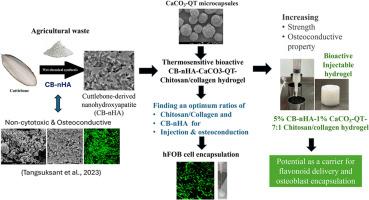Development of injectable cuttlebone derived nanohydroxyapatite hydrogel for osteoblast cell encapsulation
IF 2.2
Q3 BIOCHEMISTRY & MOLECULAR BIOLOGY
引用次数: 0
Abstract
This study focused on creating bioactive, injectable hydrogels for bone regeneration, utilizing cuttlebone derived nanohydroxyapatite (CB-nHA) and quercetin (QT), a natural flavonoid, to enhance their capacity. It explored how different ratios of CB-nHA and chitosan/collagen, along with QT, in calcium carbonate (CaCO3-QT) microcapsules influenced the injectability and osteoconductive properties of thermosensitive chitosan/collagen hydrogels. The hydrogels were prepared with varying concentrations of CB-nHA (0 %, 5 %, 10 %, and 15 % w/v) and chitosan/collagen ratios (7:1 and 14:1 w/w). Their microstructure, mechanical, and physical properties, rheological and injectability tests were examined to identify optimal hydrogel's formulations. Additionally, cytotoxicity and osteoconductivity of the hydrogel were evaluated using encapsulated human fetal osteoblasts (hFOB) obtained from ATCC (USA). It was found that higher concentrations of CB-nHA and chitosan reduced pore size and degradation while increasing complex modulus and injection force. The CaCO3-QT promoted cell growth by effectively storing and releasing QT. The optimal formulation, a 5 % CB-nHA and 1 % CaCO3-QT hydrogel with a 7:1 chitosan/collagen ratio, was injectable and exhibited a pore size of 116 ± 47 μm. The hydrogel encapsulated cells demonstrated high viability and extensive intercellular connections, with ALP activity levels significantly higher than those in the groups with 0 % CB-nHA and CaCO3 alone (p < 0.05). In conclusion, the CB-nHA and CaCO3-QT enhanced the osteoconductive property of the injectable hydrogel. A thermosensitive hydrogel composed of 5 % CB-nHA, 1 % CaCO3-QT, and a 7:1 ratio of chitosan to collagen is a bioactive and injectable carrier for osteoblasts and QT to enhance bone regeneration.

可注射海骨源纳米羟基磷灰石水凝胶用于成骨细胞包封的研制
本研究的重点是利用海螵鳝衍生的纳米羟基磷灰石(CB-nHA)和槲皮素(QT)(一种天然类黄酮)来提高骨再生的生物活性可注射水凝胶的能力。探讨了碳酸钙(CaCO3-QT)微胶囊中不同比例的CB-nHA和壳聚糖/胶原以及QT对热敏壳聚糖/胶原水凝胶的可注射性和骨导电性的影响。以不同浓度的CB-nHA(0%、5%、10%和15% w/v)和壳聚糖/胶原蛋白的比例(7:1和14:1 w/w)制备水凝胶。通过微观结构、力学和物理性能、流变性和注射性测试,确定了最佳的水凝胶配方。此外,利用美国ATCC公司的包膜人胎成骨细胞(hFOB)对水凝胶的细胞毒性和骨导电性进行了评价。结果表明,较高浓度的CB-nHA和壳聚糖可以减小孔隙尺寸和降解,同时增加复合模量和注入力。最佳配方为5% CB-nHA和1% CaCO3-QT水凝胶,壳聚糖/胶原比例为7:1,可注射,孔径为116±47 μm。水凝胶包膜后的细胞活力高,细胞间连接广泛,ALP活性水平显著高于单独添加0% CB-nHA和CaCO3组(p < 0.05)。综上所述,CB-nHA和CaCO3-QT增强了可注射水凝胶的骨传导性能。一种由5% CB-nHA、1% CaCO3-QT和7:1壳聚糖与胶原比例组成的热敏水凝胶是一种生物活性和可注射的成骨细胞和QT载体,可促进骨再生。
本文章由计算机程序翻译,如有差异,请以英文原文为准。
求助全文
约1分钟内获得全文
求助全文
来源期刊

Biochemistry and Biophysics Reports
Biochemistry, Genetics and Molecular Biology-Biophysics
CiteScore
4.60
自引率
0.00%
发文量
191
审稿时长
59 days
期刊介绍:
Open access, online only, peer-reviewed international journal in the Life Sciences, established in 2014 Biochemistry and Biophysics Reports (BB Reports) publishes original research in all aspects of Biochemistry, Biophysics and related areas like Molecular and Cell Biology. BB Reports welcomes solid though more preliminary, descriptive and small scale results if they have the potential to stimulate and/or contribute to future research, leading to new insights or hypothesis. Primary criteria for acceptance is that the work is original, scientifically and technically sound and provides valuable knowledge to life sciences research. We strongly believe all results deserve to be published and documented for the advancement of science. BB Reports specifically appreciates receiving reports on: Negative results, Replication studies, Reanalysis of previous datasets.
 求助内容:
求助内容: 应助结果提醒方式:
应助结果提醒方式:


